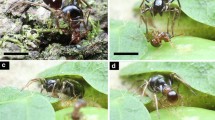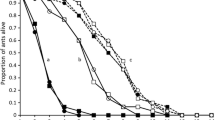Abstract
There has been considerable recent interest in the biology of spiders that specialise on ants as prey, but previous studies have tended to envisage the level of adaptation as being to ants as a group. In this paper, we provide evidence that Zodarion germanicum is a spider that has dietary and venom adaptations by which it targets a particular subset of ants, the subfamily Formicinae. We reared spiders from first instar in the laboratory on three different diets: formicine ants only, myrmicine ants only and mixed (both formicine and myrmicine ants). Fitness-related life-history parameters were determined, and we found that the spiders on the formicine-only diet lived longer and grew at a faster rate. Lipid, carbon and nitrogen compositions of ants were analysed, but we found no evidence of formicines differing from myrmicines in macro-nutrient content. This suggests that effects on longevity and growth depended on more specific nutrients or on compounds the prey uses for defence. We investigated how efficient Z. germanicum was at paralysing different ants and our findings suggest that the spider’s venom is especially effective against formicines. Taken together, our findings suggest that Z. germanicum has evolved specialisation at the level of targeting a particular ant subfamily, the Formicinae.




Similar content being viewed by others
References
AbenspergTraun M, Steven D (1997) Ant- and termite-eating in Australian mammals and lizards: a comparison. Aust J Ecol 22(1):9–17
AOAC (2006) Association of official analytical chemists. AOAC, Arlington, VA
Bilde T, Toft S (2000) Evaluation of prey for the spider Dicymbium brevisetosum Locket (Araneae: Linyphiidae) in single-species and mixed diets. Ekologia 19(Suppl 3):9–18
Binford GJ (2001) Differences in venom composition between orb-weaving and wandering Hawaiian Tetragnatha (Araneae). Biol J Linn Soc 74:581–595
Cardwell JP (1996) The evolution of myrmecophagy and its correlates in poison frogs (family Dendrobatidae). J Zool 240:75–101
Castanho LM, Oliveira PS (1997) Biology and behaviour of the Neotropical ant-mimicking spider Aphantochilus rogersi (Araneae: Aphantochilidae): nesting, maternal care and ontogeny of ant-hunting techniques. J Zool 242:643–650
Crawley MJ (2002) Statistical computing. An introduction to data analysis using S-plus. Wiley, Chichester
Duellman WE, Lizana M (1994) Biology of a sit-and-wait predator, the leptodactylid frog Ceratophrys cornuta. Herpetologica 50(1):51–64
Ferry-Graham LA, Bolnick DI, Wainwright PC (2002) Using functional morphology to examine the ecology and evolution of specialization. Integr Comp Biol 42(2):265–277
Futuyama DJ, Moreno G (1988) The evolution of ecological specialization. Ann Rev Ecolog Syst 19:207–233
Hauge MS, Nielsen FH, Toft S (1998) The influence of three cereal aphid species and mixed diet on larval survival, development and adult weight of Coccinella septempunctata. Entomol Exp Appl 89:319–323
Hölldobler B, Wilson EO (1990) The ants. Springer, Berlin
Jackson RR, Nelson XJ, Sune GO (2005) A spider that feeds indirectly on vertebrate blood by choosing female mosquitoes as prey. Proc Natl Acad Sci USA 102(52):15155–15160
Kopij G (2003) Diet of some species of Turdidae in South African grasslands. S Afr J Wildl Res 33(1):55–59
Li D, Jackson RR (1997) Influence of diet on survivorship and growth in Portia fimbriata, an araneophagic jumping spider (Araneae: Salticidae). Can J Zool 75:1652–1658
Mayntz D, Toft S (2001) Nutrient composition of the prey’s diet affects fitness of a generalist predator. Oecologia 127:207–213
Meyers JJ, Herrel A (2005) Prey capture kinematics of ant-eating lizards. J Exp Biol 208(1):113–127
Naples VL (1999) Morphology, evolution and function of feeding in the giant anteater (Myrmecophaga tridactyla). J Zool 249:19–41
Nelson XJ, Jackson RR (2006) A predator from East Africa that chooses malaria vectors as preferred prey. PLoS One 1:e132
Nelson XJ, Jackson RR, Sune G (2005) Use of Anopheles-specific prey-capture behavior by the small juveniles of Evarcha culicivora, a mosquito-eating jumping spider. J Archnol 33(2):541–548
Nielsen FH, Hauge MS, Toft S (2002) The influence of mixed aphid diets on larval performance of Coccinella septempunctata (Col., Coccinellidae). J Appl Entomol 126:194–197
Pekár S (2004) Predatory behavior of two European ant-eating spiders (Araneae, Zodariidae). J Archnol 32(1):31–41
Pekár S (2005) Predatory characteristics of ant-eating Zodarion spiders (Araneae: Zodariidae): potential biological control agents. Biol Control 34:196–203
Pekár S, Král J, Lubin Y (2005) Natural history and karyotype of some ant-eating zodariid spiders (Araneae: Zodariidae) from Israel. J Archnol 33(1):50–62
Pinheiro J, Bates D, DebRoy S, Sarkar D (2006) nlme: linear and nonlinear mixed effects models. R package version 3. pp 1–77
R Development Core Team (2006) R: A language and environment for statistical computing. R Foundation for Statistical Computing, Vienna, Austria URL http://www.R-project.org
Sih A, Christensen B (2001) Optimal diet theory: when does it work, and when and why does it fail? Anim Behav 61:379–390
Suarez AV, Richmond JQ, Case TJ (2000) Prey selection in horned lizards following the invasion of Argentine ants in southern California. Ecol Appl 10(3):711–725
Therneau T, Lumley T (2006) Survival: survival analysis, including penalised likelihood. R package version 2.29
Toft S (1999) Prey choice and spider fitness. J Archnol 27(1):301–307
Toft S, Wise D (1999) Behavioral and ecophysiological responses of a generalist predator to single- and mixed-species diets of different quality. Oecologia 119:198–207
Umeda Y, Shinkai A, Miyashita T (1996) Prey composition of three Dipoena species (Araneae: Theridiidae) specializing on ants. Acta Arachnol 45(1):95–99
Wesolowska W, Jackson RR (2003) Evarcha culicivora sp. nov., a mosquito-eating jumping spider from East Africa (Araneae: Salticidae). Ann Zool 53(2):335–338
Acknowledgements
We would like to thank D. Wanacker for help with weighing spiders, C. Haddad for correction of English and an anonymous reviewer for very constructive and helpful comments that largely improved the paper. SP was supported by a grant provided by the Carlsberg Foundation and the project no. MSM0021622416 provided by the Ministry of Education, Youth and Sports of the Czech Republic. MH was supported by the grant no. 524/05/4536 of the Czech Science Foundation. Experiments performed comply with the current laws of the Czech Republic.
Author information
Authors and Affiliations
Corresponding author
Rights and permissions
About this article
Cite this article
Pekár, S., Toft, S., Hrušková, M. et al. Dietary and prey-capture adaptations by which Zodarion germanicum, an ant-eating spider (Araneae: Zodariidae), specialises on the Formicinae. Naturwissenschaften 95, 233–239 (2008). https://doi.org/10.1007/s00114-007-0322-3
Received:
Revised:
Accepted:
Published:
Issue Date:
DOI: https://doi.org/10.1007/s00114-007-0322-3




